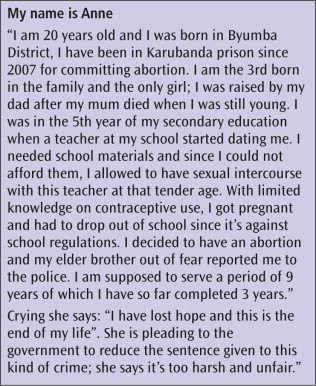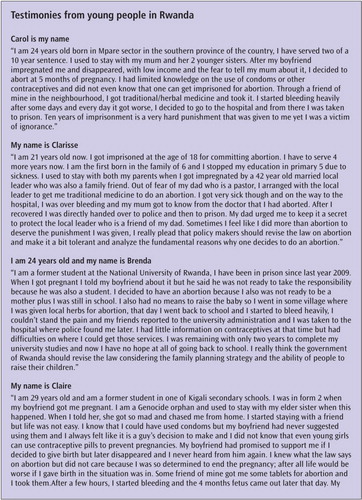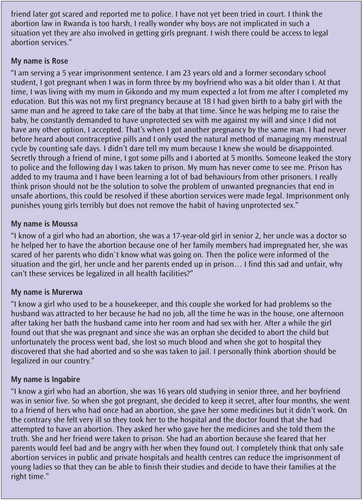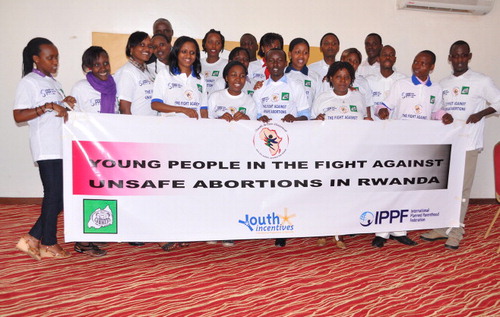Abstract
In June 2012, a new abortion law came into effect in Rwanda as part of a larger review of Rwanda's penal code. This was a significant step in a country where it was previously taboo even to discuss abortion. This article describes some of the crucial elements in how this success was achieved in Rwanda, which began through a project launched by Rutgers WPF on “sensitive issues in young people's sexuality” in several countries. This paper describes how the Rwandan Youth Action Movement decided to work on unsafe abortion as part of this project. They gathered data on the extent of unsafe abortion and testimonies of young Rwandan women in prison for abortions; organized debates, values clarification exercises, interviews and a survey in four universities; launched a petition for law reform; produced awareness-raising materials; worked with the media; and met with representatives from government ministries, the national women's and youth councils, and parliamentarians – all of which played a significant role in the advocacy process for amendment of the law, which was revised when the penal code came up for review in June 2012. This history shows how important the role of young people can be in producing change and exposes, through personal stories, the need for a better abortion law, not only in Rwanda but also elsewhere.
Résumé
En juin 2012, une nouvelle loi sur l'avortement est entrée en vigueur au Rwanda, dans le cadre d'un examen élargi du code pénal rwandais. C'était un progrès important dans un pays où il était auparavant tabou même de parler d'avortement. Cet article décrit certains des éléments essentiels pour parvenir à ce succès, qui a commencé par un projet lancé par Rutgers WPF sur « les questions sensibles de la sexualité des jeunes » dans plusieurs pays. L'article décrit comment le Mouvement rwandais d'action des jeunes a décidé de travailler sur l'avortement à risque au titre de ce projet. Il a recueilli des données sur l'ampleur de ce phénomène et des témoignages de jeunes Rwandaises en prison pour avortement, et a organisé des débats, des exercices de clarification des valeurs, des entretiens et une enquête dans quatre universités. Il a lancé une pétition pour la réforme de la loi, a produit du matériel de sensibilisation et a collaboré avec les médias. Le Mouvement a rencontré des représentants de ministères, des conseils nationaux des femmes et des jeunes, ainsi que des parlementaires qui tous ont contribué grandement au processus de plaidoyer pour l'amendement de la loi, qui a été révisée lors de l'examen du code pénal en juin 2012. Cette histoire montre le rôle important que les jeunes peuvent jouer pour déclencher le changement et expose, avec des récits personnels, la nécessité d'une meilleure loi sur l'avortement au Rwanda, mais aussi ailleurs.
Resumen
En junio de 2012 entró en vigor una nueva ley referente al aborto en Ruanda como parte de una modificación general del Código Penal ruandés. Éste fue un paso importante en un país donde anteriormente era tabú incluso hablar sobre aborto. En este artículo se describen algunos de los elementos cruciales de este logro, que comenzó por medio de un proyecto iniciado por Rutgers WPF sobre “temas delicados relacionados con la sexualidad en la adolescencia” en varios países. Se describe cómo el Movimiento Ruandés de Juventud en Acción decidió trabajar en asuntos de aborto inseguro como parte de este proyecto. Recolectaron datos sobre la magnitud del aborto inseguro y testimonios de mujeres jóvenes ruandesas encarceladas por tener abortos; organizaron debates, ejercicios de aclaración de valores, entrevistas y una encuesta en cuatro universidades; entablaron una petición de reforma legislativa; produjeron material de concientización; trabajaron con los medios de comunicación; y se reunieron con representantes de ministerios gubernamentales, consejos nacionales de mujeres y jóvenes, y parlamentarios. Todos ellos desempeñaron un papel decisivo en el proceso para modificar la ley, lo cual sucedió cuando el código penal fue revisado en junio de 2012. Esta historia demuestra la importancia del rol de la juventud para producir cambios y expone, mediante historias personales, la necesidad de tener mejores leyes de aborto, no solo en Ruanda sino también en otros países.
“Some grown-ups think we are too young to know, they should know that we are too young to die.”(Youth advocate, age 19)
Nevertheless, the amendment of the law is a significant first step in a country where at least the taboo on even discussing the topic of abortion has now been broken. Unsafe abortion and its consequences for Rwandan youth have been put on the national agenda for the first time, with debates organized at the highest levels, including with representatives of the Ministry of Health, the Ministry of Gender and Family Promotion, the Ministry of Justice, the National Women's Council and National Youth Council, among others.Citation2
This article describes how this success was achieved.
A project on sensitive issues of sexuality
In 2009, Rutgers WPF, a Dutch NGO working on sexual and reproductive health and rights in the Netherlands and supporting work on these issues in the global South, decided to launch a programme with young people on some extremely sensitive issues of sexuality within its international programme, at the time called Youth Incentives. The issues we decided to focus on included sexual violence, abortion and sexual diversity. This programme involved working with International Planned Parenthood (IPPF) members in Rwanda, Malawi, Mali, Tanzania and Bangladesh and, specifically, with the youth movements attached to these partners, who together had formed a Youth Action Movement.
A study tour in the Netherlands for six Youth Action Movement members from each of the five countries was organised in 2009. The objectives of the study tour were to: (1) increase acceptance and progressive attitudes towards the sensitive issues; (2) increase the motivation to be involved in addressing sensitive issues; (3) build the capacity of young people to address sensitive issues; and (4) explore the possibilities for young people's groups to evoke changes in attitudes regarding these issues within their communities. The next step was to formulate action plans for a national event and a series of national activities in each country. The events, organised in 2010, aimed at spreading the word and increasing awareness, acceptance and skills to discuss sexual violence, abortion and sexual diversity among youth representatives across the region. Youth Action Movement members who participated in the study tour co-facilitated regional events for YAM members from 20 other IPPF member associations of various countries in Africa and Asia. Finally, national action plans for work in these countries were drafted by Youth Action Movement members, based on the experiences gained through the study tour and events, with the support of Rutgers WPF/Youth Incentives and the IPPF regional offices and partners involved.
This paper focuses on the events and activities that took place in Rwanda which led to the changes in the abortion law. Six youth representatives from Rwanda were involved in the study tour to the Netherlands. They were members of the youth branch of the Association Rwandaise pour le Bien-Être Familial (ARBEF), an IPPF member since 1987. ARBEF had initiated this youth branch to enhance youth participation and involvement, aimed at empowering young people regarding their sexual and reproductive health and promote informed decisions regarding their lives. There are currently about 500 youth volunteers representing different parts of the country who are engaged in different ARBEF projects, some of whom are part of the decision-making board of ARBEF. During the study tour in the Netherlands, YAM Rwanda's members decided that their national action plan was going to focus on the issue of safe abortion.
Youth Action Movement Rwanda and its focus on abortion
ARBEF, its Youth Action Movement and Rutgers WPF believe that young people have the right to comprehensive information and services that promote their sexual and reproductive well-being, including safe abortion services. This right is guaranteed by international human rights treaties, such as the Convention on the Rights of the Child (1990) and the African Charter on the Rights and Welfare of the Child (1999). It is also emphasized in intergovernmental agreements such as the ICPD Programme of Action (1994) and the Millennium Development Goals. It is within this context that YAM decided to learn more about the abortion situation in Rwanda and to collect and compile stories from young people affected by unsafe abortion.
World Health Organization research has found that adolescents with unwanted pregnancies tend to delay seeking abortion, resort to less skilled providers, use more dangerous methods and delay seeking care for complications.Citation4 All this results in relatively high vulnerability for abortion-related morbidity and mortality among young women. In low and middle-income countries, pregnancy, abortion and delivery-related problems are the number one cause of death among young women between 15 and 19 years of age.Citation5
Unsafe abortion is a concern for Rwandan young women because it is illegal and what happens is hidden. A 2005 study estimated that 50% of obstetric complications were a consequence of spontaneous and induced abortions.Citation3 A 2012 study by Basinga et al showed that 10 per 1,000 women aged 15–49 had been treated for complications of unsafe abortion in health facilities in Rwanda, the number being even higher when it included women who had experienced complications that were not documented.Citation6 For adolescent girls and young women, this situation is likely worse as they are condemned for being pregnant and having children outside marriage. Those living with their parents are often thrown out of their parents' homes and those who are in school are often dismissed when they get pregnant. Being denied safe abortion services, young women use unsafe means such as traditional herbs to abort pregnancies.
The abortion law in Rwanda is very restrictive and blocks the development of initiatives related to making abortion services safe. This law disregards the various reasons why unintended pregnancies among young people occur, including the lack of emergency contraception and low access to family planning services. In Rwanda, the unmet need for contraception stands at 38% among women aged 15–49. For young people unmet need is likely to be far higher because contraception is treated as a practice for married people, as has recently been found in Uganda and Kenya.Citation7,8
To these factors one must add that of sexual violence: in 2008, UNIFEM conducted a study in four districts in Rwanda and found that 86% of women who responded had been subjected to rape or attempted rape by a family member or in a familiar environment, such as the workplace.Citation9 Such experiences often led to unintended pregnancies, some of which occurred in the context of incest. Thus, the need for access to safe abortion increases enormously, making the promotion of safe abortion services urgent.
Throughout 2010 and 2011, the young people in YAM Rwanda took up the challenge to try and improve the situation related to abortion in Rwanda. They started to collect data from hospitals and prisons to fill the gap in the lack of data on unsafe abortion and the effects of criminalization of abortion in Rwanda, not least for young girls, and gathered testimonies from girls in prison serving a sentence for having undergone an abortion. By 13 July 2010, they had learned that 21 out of 114 women in Karubanda prison were there due to having illegal abortions; 90% were 25 years old or younger.
In boxes throughout this article are a number of the testimonies that were obtained by the first author and other YAM interviewers. These stories have been used throughout the advocacy campaign to move people to action. Because of the stigma attached to abortion in Rwanda, fear among the girls to tell their stories was high. All names used here are pseudonyms. At this writing, some of these girls will have been released upon completion of their time, but some of them will still be in prison. Unfortunately, the new law did not alter their sentences.
Using these testimonies to mobilize for law reform
The testimonies were used by the YAM in meetings and gatherings with over 1,000 students in one university in Kigali (Kigali Institute of Education) and three universities in the provinces (Kigali Independent University Gisenyi Campus, Higher Institute of Agriculture and Animal Husbandry Busogo, and National University of Rwanda). Their aim was to mobilize the support of a critical mass of young people around the issue and to gather their views on abortion through debates, interviews and a survey. The survey showed that 97% of 520 students (57% male, 43% female) were in favour of making changes to the very restrictive law and supported a petition to this effect drafted by the YAM.
The testimonies, interviews, petition and data from hospitals were used to produce information and awareness-raising materials. The booklets with testimonies were distributed at different government offices and the materials and information were used by YAM members during strategic and political follow-up events in 2011 with representatives from youth-serving civil society organizations, the Rwandan Ministry of Health, Ministry of Gender and Family Promotion, Ministry of Justice, National Women Council, National Youth Council, Women Parliamentarians Organization and Parliamentarians' Network for Health and Development.
In order to ensure respectful and constructive discussions on abortion during those workshops the methodologies used in the study tour and regional events which provoked empathy and reflection were also used in Rwanda in combination with factual knowledge. These methods included, for instance, values clarification exercises and reflection on testimonies and real cases (see the Rutgers WPF Toolkit for more methods for addressing sensitive themes).Citation10–12
The testimonies and stories of young people gave a “face” to the issue of unsafe abortion. Though some participants remained strongly opposed to legalising abortion, most workshop participants realised that there is more to the “crime” of abortion than the supposed immorality of the girl or woman. They also realized that structural social problems like gender inequality, sexual violence and lack of access to information and contraception were important causative factors. An important condition for success in achieving understanding during the workshops was that everybody was entitled to their own opinion, which should be respected.
An important strategy that the YAM used was the mapping of civil society organizations serving youth, with the greatest potential to influence public opinion and decision-making regarding abortion in Rwanda. Representatives of these organizations were invited to a three-day sensitization workshop. Fifty representatives from 30 youth-serving organizations attended the workshop, with the majority eventually subscribing to YAM's position paper on safe abortion. YAM and ARBEF's leading role in advocacy for safe abortion has resulted, among other things, in various forms of collaboration with other organizations, such as the Center for Reproductive Rights, Guttmacher Institute, Venture Strategies Innovations and Ipas.Citation13 Likewise, YAM has used values clarification and other workshop exercises to identify policy makers and stakeholders who would support their cause and followed up with them for collaborative advocacy activities.
The workshops that YAM organised attracted the attention of the media. Different newspaper agencies (e.g. New Vision, InvahoNshya, La Nouvelle Releve) and radio stations (IsangoStar and BBC Radio) were present, and the following week the newspapers had put abortion advocacy issues on their front pages and radio news reported on the presentations. This attention helped to create public awareness and debate.
The fact that it was the young people themselves who addressed this important but sensitive issue and called for changes in the law made an impact on policy makers. Finally, these efforts coincided with important policy events, like the revision of Rwanda's penal code and the ratification of some international and regional conventions that supported the granting of women's reproductive rights, notably the Protocol to the African Charter on Human Rights and on the Rights of Women in Africa, whose 14th article says:
“States Parties shall take all appropriate measures to: protect the reproductive rights of women by authorizing medical abortion in cases of sexual assault, rape, incest, and where the continued pregnancy endangers the mental and physical health of the mother or the life of the mother or the fetus”.
In September 2012, supported by factsheets on the new law, YAM brought the issue of unsafe abortion in Rwanda to the attention of parliamentarians of several African countries during a consultative meeting, organized by IPPF in cooperation with the Rwandan government on ICPD, the MDGs and the new development agenda. This abortion project, which started as a small pilot initiative by Rutgers WPF, ARBEF and YAM Rwanda, has now become a full-fledged advocacy programme and has secured funds from other donors to keep it going, such as the Safe Abortion Action Fund.
Former YAM volunteer and first author of this article, Chantal Umuhoza, has become the coordinator of this project. In 2013 and 2014, she will continue to guide activities towards collecting more data and evidence and towards engaging even more Rwandan civil society organizations. The aim is to showcase that the new law will have to be subjected to further revision and that a number of restrictions will have to be removed before the reproductive rights of women and girls in Rwanda can be sufficiently realized.
Closing remarks
We hope that, by making this history and these testimonies available to a wider audience of youth intermediaries, policy makers, civil society organizations serving young people and young people themselves, they will gain greater insight into the situation of unsafe abortion and will feel enabled to improve their strategies in addressing this issue, both in Rwanda and elsewhere. We also hope that by sharing this process of change in Rwanda, we have shown how important the role of young people can be in producing change. We hope this will inspire more young people to take up this role and adults and organizations to support them in doing so.
Acknowledgements
The initiative described here was funded by the Netherlands Ministry of Foreign Affairs. The authors would like to acknowledge the extraordinary work of all the youth volunteers of the Youth Action Movement who were involved in making these changes happen, as well as ARBEF and IPPF's central and regional offices for training and supporting these young people and to the International Campaign for Women's Right to Safe Abortion for their support in disseminating the stories of the young women in prison to a wider audience.
References
- M Kaitesi. Doctors deployed to rural hospitals. New Times. 20 September 2012. http://newtimes.co.rw/news/index.php?i=15121&a=58535
- Youth Action Movement Rwanda. Abortion and young people in Rwanda: a booklet with personal stories on abortion. 1 March 2012. www.rutgerswpf.org/article/abortion-and-young-people-rwanda-booklet-personal-stories-abortion
- L Pearson, R Shoo. Availability and use of emergency obstetric services: Kenya, Rwanda, Southern Sudan, and Uganda. International Journal of Gynecology and Obstetrics. 88(2): 2005; 208–215.
- World Health Organization. Adolescent reproductive health. www.who.int/maternal_child_adolescent/topics/maternal/reproductive_health/en/
- S Singh. Adding it up: the costs and benefits of investing in family planning and maternal and newborn health. 2009; Washington DC/New York: Guttmacher Institute/UNFPA.
- P Basinga, AM Moore, SD Singh. Abortion incidence and postabortion care in Rwanda. Studies in Family Planning. 43: 2012; 11–20.
- G Nalwadda, F Mirembe, J Byamugisha. Persistent high fertility in Uganda: young people recount obstacles and enabling factors to use of contraceptives. BMC Public Health. 10: 2010; 530.
- CO Izugbara, R Ochako, C Izugbara. Gender scripts and unwanted pregnancy among urban Kenyan women. Culture Health and Sexuality. 13: 2011; 1031–1045.
- UNIFEM. Baseline survey on sexual and gender based violence in Rwanda. 2008; UNIFEM: Kigali. www.unifem.org/attachments/products/
- WPF Rutgers. Brochures and training materials on sensitive themes. www.rutgerswpf.org/content/downloads
- Van Reeuwijk M, Van Zorge R. Addressing sensitive themes: strategies and methods that help to address sexual violence, unsafe abortion and sexual diversity. Paper presented on behalf of Rutgers WPF at: 5th Africa Conference on Sexual Health and Rights. Windhoek, 19–22 September 2012.
- Youth Action Movement. Report of YAM advocacy project on abortion and young people in Rwanda. 2011. www.rutgerswpf.org/sites/default/files/YAM%20report%20on%20safe%20abortion%20advocacy%20project.pdf
- M Kaitesi. Advocacy group calls for decriminalization of abortion. New Times. 23 December 2011. www.newtimes.co.rw/news/index.php?i=14848&a=48389&icon=Results&id=2



